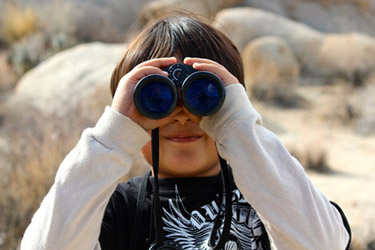Binoculars Basics for Beginners
As a beginner, you might wonder about the basic functions of binoculars and how important they are for bird watching. When choosing binoculars, the magnification and objective lens diameter and size and weight are important items to consider. Lens coatings, weather-resistances, and relative brightness for low-light situations are also on the list. Let's take a look at each one individually.
Magnification
Binoculars have two numbers associated with them, separated by the symbol for times. An example is 8x42, where 8 represents the magnification and 42 is the objective lens diameter. Magnification indicates the field of view. The 8 in this example means that the birds you see will appear 8 times closer than with your naked eye. The higher the number, the closer they will appear.
Objective Lens Diameter
In our example of 8x42, the second number indicates the diameter (in millimeters) of the front (objective) lens. The larger the diameter, the brighter the image will be, and the heavier the binoculars will be. Larger objective lens sizes are great for low-level lighting situations, such as dawn, dusks, night sky, and shaded areas. Smaller ones will do when the ambient light is good.
See binoculars on Amazon.com...

Exit Pupil Size
If you divide the objective lens diameter by the magnification, you get the pupil size and the relative brightness of the lens. In our example, 42mm / 8 is 5.25 mm. The higher the exit pupil size, the more light will reach your eyes. As a rule of thumb, 1 to 2 mm is good for bright light, 2 to 4 is good for typical daylight, 4 to 6 works for low light situations, and 7 is best for nighttime.
Relative Brightness
If you multiply the exit pupil size by itself (5.25 x 5.25 = 27.5) you obtain the relative brightness. While there are other factors, such as coatings and prism type that affect this, the relative brightness calculation is a good indicator of how bright the birds will appear. Higher numbers are better for low-light situations.
Size and Weight
Size and weight are important for two reasons. The first reason is that heavier binoculars are harder to carry around on long days of birding. If you choose a pair that is too heavy for you, your enjoyment for this hobby may dwindle. If you're stationed in a blind for a few hours, you can put the binoculars down to rest, but if you are walking along trails, the weight can take its toll. The second reason is that larger binoculars take up more room. If you're traveling, consider the size of your luggage and the size of your backpack, when choosing your binoculars.
"I'm going to need more than one pair!"
Well, maybe, but start with one and see where it takes you.
Lens Coatings
Lens coatings for binoculars are useful in that they reduce the amount of reflection, which increases light transmission. Basically that means that the better the coatings, the clearer and sharper the bird images will be.
Water, Weather, and Fog
Ocean breezes, rainy days, moisture in the air, and fog can allow moisture to seep in between your binoculars' lens. Waterproof and weather-resistant binoculars have O-rings that seal each lens from moisture and dust. Inert gas is used to stop moisture from forming on the inner sides of each lens. If your bird watching takes you to dry climates, keeping moisture out may not be a concern, but dust can be.
I hope these Binoculars Basics for Beginners gives you a better understanding and helps you on the road to choosing your first pair!
Next: Read the "Binoculars Field of View Explained" article...